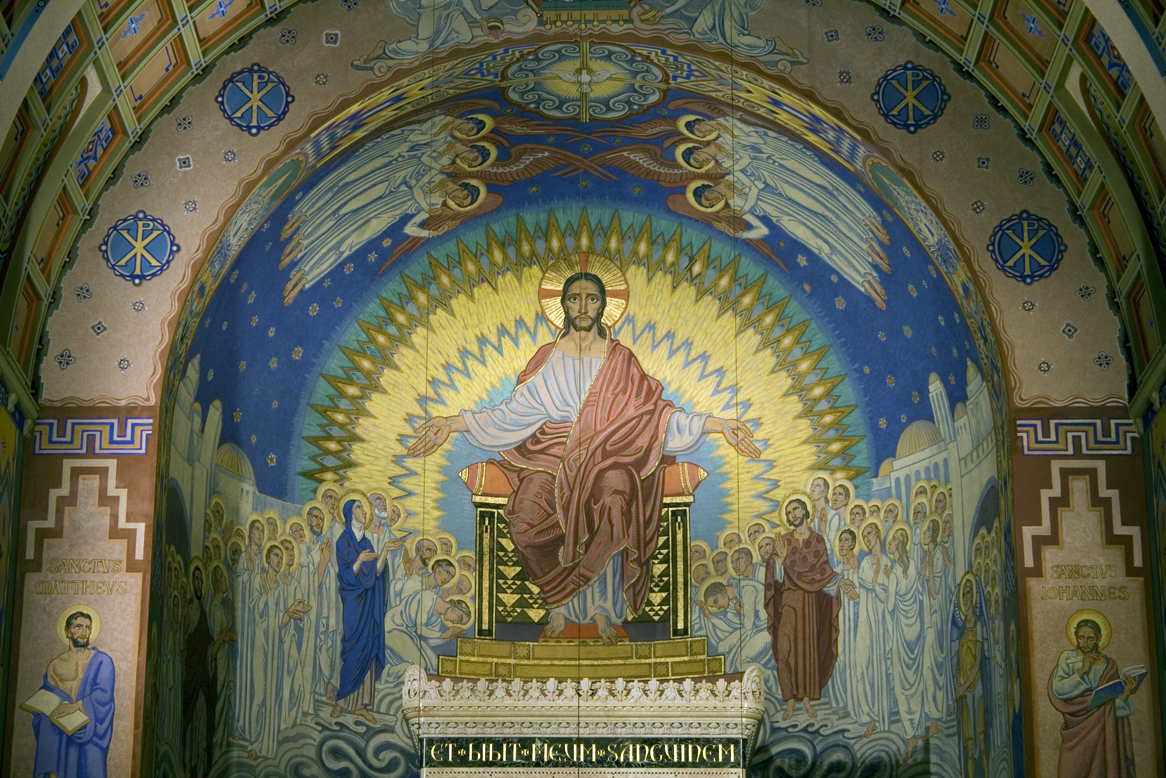 I had the good fortune to visit the Cathedral of Saint Joseph in Wheeling, West Virginia this weekend, and was again astounded by the beautiful murals painted the in the 1920s by Felix Lieftuchter (click for larger version). More important than the artist’s evident technical skill is the theological understanding shown in the murals. This is perhaps one of the purest liturgical images of the twentieth century. What we see here is the liturgy of heaven, which is the same liturgy in which we earthly beings participate at Mass. Here is the heavenly liturgy as described in the Book of Revelation: the One seated on the throne with evident glory and power over sin and death, the white robed multitudes, the angels– the saints all with their gaze on Christ.Yet Christ is not Zeus, but a figure of strength with pleading eyes, the God who touches John on the shoulder and says “do not be afraid.” The river of the water of life, which the Catechism calls a symbol of the Holy Spirit, gushes over the walls and into the earthly realm. Even the stars are glorified and glorify God by their obedient following of their orbits.
I had the good fortune to visit the Cathedral of Saint Joseph in Wheeling, West Virginia this weekend, and was again astounded by the beautiful murals painted the in the 1920s by Felix Lieftuchter (click for larger version). More important than the artist’s evident technical skill is the theological understanding shown in the murals. This is perhaps one of the purest liturgical images of the twentieth century. What we see here is the liturgy of heaven, which is the same liturgy in which we earthly beings participate at Mass. Here is the heavenly liturgy as described in the Book of Revelation: the One seated on the throne with evident glory and power over sin and death, the white robed multitudes, the angels– the saints all with their gaze on Christ.Yet Christ is not Zeus, but a figure of strength with pleading eyes, the God who touches John on the shoulder and says “do not be afraid.” The river of the water of life, which the Catechism calls a symbol of the Holy Spirit, gushes over the walls and into the earthly realm. Even the stars are glorified and glorify God by their obedient following of their orbits.
There are those out there who might call this a “distraction” from the liturgy. However, a better understanding knows that this is the liturgy. Just as we can sing the liturgy, so we can see it. This mural, then, is the visual equivalent of the Sanctus:
“In love you created man, in justice you condemned him, but in mercy you redeemed him through Jesus Christ our Lord. Through him the angels and all the choirs of heaven worship in awe before your presence. May our voices be one with theirs as they sing with joy the hymn of your glory: Holy, holy, holy Lord, God of power and might, heaven and earth are full of your glory, Hosanna in the highest.”
Catholics deserve more than cream-colored drywall in their churches. And we would all do well to remember that the liturgy is more than the earthly gathering, but is instead the intersection of heaven and earth glorifying God and sanctifying humanity. This is our faith, our inheritance and our delight.

Leave a Reply